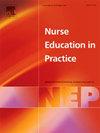Utilization of simulation in undergraduate clinical nursing skills training: A cross-sectional study in China
IF 3.3
3区 医学
Q1 NURSING
引用次数: 0
Abstract
Aim
This study seeks to explore the challenges and experiences of nurse educators in adopting simulation in undergraduate clinical skills training in China.
Background
Despite global recognition in nursing education, simulation's role in Chinese nursing schools' clinical skills training is largely uncharted.
Design
A cross-sectional study.
Methods
An online questionnaire was developed and disseminated among nurse educators. It garnered responses from 123 participants representing 50 undergraduate colleges across China.
Results
Of the respondents, 59 (47.9 %) reported using simulation as a teaching method in clinical skills training. However, a mere five (8.5 %) were acquainted with and applied the Healthcare Simulation Standards of Best Practice in their simulation processes. The earliest adoption of simulation occurred in 1998, with the latest instance in 2019. Role-playing (91.5 %) and task trainers (86.4 %) were the predominant simulation modalities. Most participants exhibited a deficiency in skills necessary for managing simulation activities, including structured pre-briefing, facilitation and handling technological debriefing issues. A mere seven (11.9 %) of the teachers utilized valid and reliable instruments to assess simulation experiences.
Conclusions
The use of simulation in undergraduate clinical nursing skills training in China is not only infrequent but also lacks adherence to a best practice framework. Four significant challenges were identified for nurse faculty using simulation: (1) the design of standardized scenarios; (2) encouraging active student participation in simulation and debriefing; (3) the prolongation of simulation due to technical issues; and (4) the constraint of limited class time allowing only a few students to engage in simulation.
模拟在本科临床护理技能培训中的应用:一项在中国的横断面研究
目的探讨中国护士教育工作者在本科临床技能培训中采用模拟教学所面临的挑战和经验。尽管护理教育得到了全球的认可,但模拟在中国护理学校临床技能培训中的作用在很大程度上是未知的。设计横断面研究。方法制作一份在线调查问卷,并在护理教育工作者中发放。该调查获得了来自全国50所本科院校123名参与者的回复。结果59人(47.9 %)在临床技能培训中采用模拟教学方法。然而,只有五家(8.5 %)熟悉并在其模拟过程中应用了最佳实践的医疗保健模拟标准。最早采用模拟技术是在1998年,最近一次是在2019年。角色扮演(91.5% %)和任务训练员(86.4 %)是主要的模拟方式。大多数参与者表现出缺乏管理模拟活动所需的技能,包括结构化的预先简报、促进和处理技术简报问题。只有7名教师(11.9 %)使用有效可靠的工具来评估模拟经验。结论在中国的本科临床护理技能培训中,模拟教学的使用不仅很少,而且缺乏对最佳实践框架的遵守。研究人员确定了护士教师在使用模拟时面临的四大挑战:(1)标准化场景的设计;(2)鼓励学生积极参与模拟和汇报;(3)由于技术问题导致模拟时间延长;(4)课堂时间有限,只有少数学生参与模拟。
本文章由计算机程序翻译,如有差异,请以英文原文为准。
求助全文
约1分钟内获得全文
求助全文
来源期刊

Nurse Education in Practice
NURSING-
CiteScore
5.40
自引率
9.40%
发文量
180
审稿时长
51 days
期刊介绍:
Nurse Education in Practice enables lecturers and practitioners to both share and disseminate evidence that demonstrates the actual practice of education as it is experienced in the realities of their respective work environments. It is supportive of new authors and will be at the forefront in publishing individual and collaborative papers that demonstrate the link between education and practice.
 求助内容:
求助内容: 应助结果提醒方式:
应助结果提醒方式:


